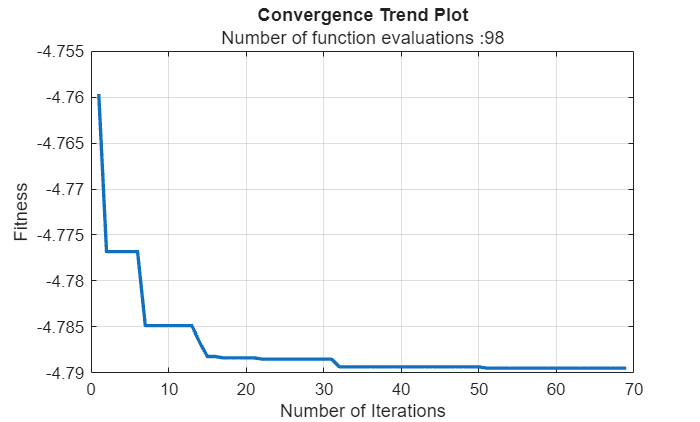isConverged
Syntax
Description
Examples
Create a dipole antenna resonating at 75 MHz and calculate its maximum directivity.
Choose its length and width as design variables. Provide lower and upper bounds of length and width.
referenceAnt = design(dipole,75e6); InitialDirectivity = max(max(pattern(referenceAnt,75e6)))
InitialDirectivity = 2.1002
Bounds = [3 0.11; 7 0.13];
Use the SADEA optimizer to optimize this dipole antenna for its directivity. Specify an evaluation function for optimization using the CustomEvaluationFunction property of the OptimizerSADEA object. The evaluation function used in this example is defined at the end of this example.
s = OptimizerSADEA(Bounds); s.CustomEvaluationFunction = @customEvaluationOnlyObjective;
Run the optimization for 100 iterations.
figure s.optimizeWithPlots(100);

View the best member data.
bestDesign = s.getBestMemberData
bestDesign =
bestMemberData with properties:
member: [4.7998 0.1101]
performances: -4.7895
fitness: -4.7895
bestIterationId: 50
bestdesignValues = bestDesign.member
bestdesignValues = 1×2
4.7998 0.1101
Update the reference antenna with best design values from the optimizer. Calculate directivity of the optimized design.
Observe an increase in directivity value after optimization.
referenceAnt.Length = bestdesignValues(1); referenceAnt.Width = bestdesignValues(2); postOptimizationDirectivity = max(max(pattern(referenceAnt,75e6)))
postOptimizationDirectivity = 4.7895
View the surrogate model data used for prediction.
InitialData = s.getInitializationData
InitialData =
initializationData with properties:
members: [30×2 double]
performances: [30×1 double]
fitness: [30×1 double]
View the data for all iterations.
iterData = s.getIterationData
iterData =
iterationData with properties:
members: [68×2 double]
performances: [68×1 double]
fitness: [68×1 double]
Check if the algorithm has converged.
ConvergenceFlag = s.isConverged
ConvergenceFlag = logical
1
Check how many times the evaluation function is computed.
NumEvaluations = s.getNumberOfEvaluations
NumEvaluations = 98
Plot the convergence trend.
s.showConvergenceTrend

Following code defines the evaluation function used in this example.
function fitness = customEvaluationOnlyObjective(designVariables) fitness = []; try % Create geometry ant = design(dipole,75e6); ant.Length = designVariables(1); ant.Width = designVariables(2); catch % Handle errors during geometry creation. % High penalty value is used to handle errors. fitness = 1e6; end if isempty(fitness) try % Calculate directivity % Optimizer always minimizes the objective hence reverse the sign to maximize gain. objective = max(max(pattern(ant,75e6))); objective = -objective; catch % Handle errors during gain computation. % High penalty value is used to handle errors. objective = 1e6; end % As there are no constraints, fitness equals objective. fitness = objective; end end
Input Arguments
Optimizer, specified as an OptimizerSADEA or OptimizerTRSADEA object. The function checks the convergence status of the
optimizer specified in obj.
Example: OptimizerSADEA
Output Arguments
Status of optimizer convergence, returned as one of these logical values:
0if the optimizer has not reached convergence1if the optimizer has reached convergence
Version History
Introduced in R2025a
See Also
Objects
Functions
MATLAB Command
You clicked a link that corresponds to this MATLAB command:
Run the command by entering it in the MATLAB Command Window. Web browsers do not support MATLAB commands.
Select a Web Site
Choose a web site to get translated content where available and see local events and offers. Based on your location, we recommend that you select: .
You can also select a web site from the following list
How to Get Best Site Performance
Select the China site (in Chinese or English) for best site performance. Other MathWorks country sites are not optimized for visits from your location.
Americas
- América Latina (Español)
- Canada (English)
- United States (English)
Europe
- Belgium (English)
- Denmark (English)
- Deutschland (Deutsch)
- España (Español)
- Finland (English)
- France (Français)
- Ireland (English)
- Italia (Italiano)
- Luxembourg (English)
- Netherlands (English)
- Norway (English)
- Österreich (Deutsch)
- Portugal (English)
- Sweden (English)
- Switzerland
- United Kingdom (English)